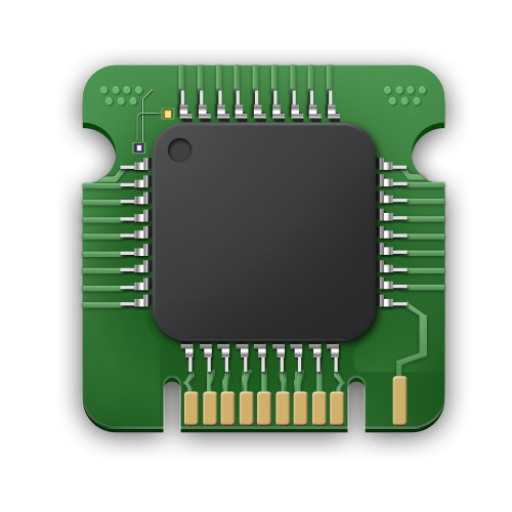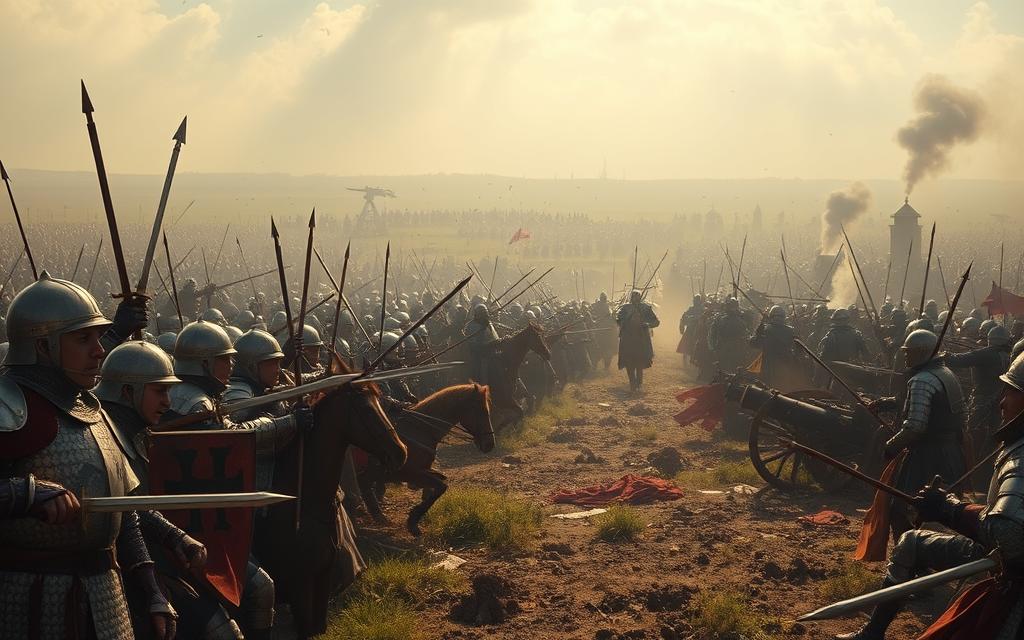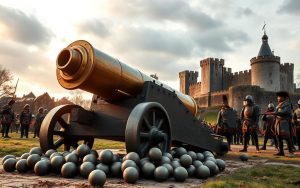The Hundred Years War, a conflict that lasted from 1337 to 1453, was a pivotal period in European history that witnessed significant technological innovations. This century-long war drove military necessity, leading to revolutionary developments in weapons, armor, tactics, and logistics.
The war marked a significant shift in the nature of warfare, with power transitioning from mounted knights to infantry and artillery. The century saw innovation in various fields, laying the groundwork for European military dominance in later centuries.
This article will explore the technological advancements that emerged during this period, examining how they transformed the world and shaped the course of history.
The Hundred Years War: Historical Context and Overview
The Hundred Years War, spanning from 1337 to 1453, was a pivotal conflict in European history. This prolonged struggle between the English and French royal houses was marked by periods of intense fighting interspersed with periods of relative calm. The war was not a single, continuous conflict but rather a series of wars fought over succession rights to the French throne and territorial claims.
Origins of the Conflict (1337-1453)
The Hundred Years War began as a dynastic conflict between the English Plantagenets and French Valois over territorial claims and succession rights to the French throne. When French King Charles IV died without issue in 1328, his English nephew Edward III claimed the French throne, but the French feudal elite rejected him, instead anointing Philip, Count of Valois, as King Philip VI. Tensions escalated when Philip confiscated lands considered English possessions, leading to armed conflict.
The war’s onset was marked by a series of skirmishes and battles, as both sides sought to assert their claims. The English initially enjoyed successes, leveraging their longbowmen and tactical innovations to counter the traditional French knights. The conflict’s early phase, known as the Edwardian War (1337-1360), saw significant English victories, including the Battle of Crécy in 1346.
The Three Phases of the War
The Hundred Years War can be divided into three distinct phases: the Edwardian (1337-1360), Caroline (1369-1380), and Lancastrian (1415-1453) periods. Each phase presented unique military challenges and technological developments. The Edwardian phase was characterized by English successes, while the Caroline phase saw a resurgence of French fortunes under Charles V. The Lancastrian phase, marked by the rise of Henry V of England, witnessed significant English victories, including the Battle of Agincourt in 1415.
Throughout these phases, the nature of warfare evolved significantly. Traditional feudal armies gave way to more complex forces incorporating professional soldiers, common infantry, and specialized units. The war’s duration and geographic scope drove technological innovations, particularly in siege warfare and naval technology.
Why Technology Mattered in This Conflict
The Hundred Years War was a crucible for military innovation, as both sides sought advantages through new weapons, tactics, and organizational structures. The conflict saw the introduction and development of various technologies, including the longbow, gunpowder weapons, and improved fortifications. These technological advancements had a profound impact on the conduct of warfare, influencing tactics, and ultimately, the outcome of battles.
The war’s unprecedented duration created a laboratory for military innovation, driving the development of new technologies and tactics. The changing nature of warfare during this period reflected broader social and economic transformations, as the medieval military system struggled to adapt to new technologies and tactics. The Hundred Years War thus played a significant role in shaping the course of military history.
The Evolution of Armor: From Chain Mail to Plate
The onset of the Hundred Years War in the 14th century saw armor technology shift dramatically, from chain mail to articulated plate armor. This transition was not merely a matter of preference but a response to the evolving nature of warfare during this period.
Chain Mail at the Beginning of the War
At the start of the Hundred Years War, chain mail was the predominant form of armor. It offered reasonable protection against slashing weapons but was vulnerable to thrusting attacks and arrows. The use of chain mail was widespread among knights and men-at-arms due to its flexibility and relatively lighter weight.
Chain mail armor was made from thousands of interlocking iron rings, which provided a decent level of protection. However, as weapons became more powerful and penetrating, the limitations of chain mail became apparent. The need for better protection drove the development of new armor technologies.
The Development of Plate Armor
The 14th century witnessed a revolutionary transition to plate armor. Articulated steel plates were designed to cover the entire body, providing superior protection against the increasingly powerful weapons of the period. Plate armor was not only more protective but also surprisingly flexible, allowing for a considerable range of motion.
The development of plate armor was a technological arms race. Armorers continually innovated to counter improvements in weapons, particularly the longbow and early firearms. The result was a sophisticated assemblage of articulated plate armor that was both protective and flexible.
| Armor Type | Protection Level | Weight | Flexibility |
|---|---|---|---|
| Chain Mail | Moderate | Relatively Light | High |
| Plate Armor | High | Approximately 20kg | Moderate to High |
Impact on Battlefield Tactics and Mobility
The transition to plate armor had a significant impact on battlefield tactics and mobility. Knights and men-at-arms wearing plate armor were more protected and thus could engage in combat more effectively. However, the weight and cost of plate armor meant that only the wealthier warriors could afford it, influencing the social organization of armies.
Despite common misconceptions, full plate armor was remarkably flexible, with most suits weighing no more than 20kg (45lbs). This allowed knights to move with considerable agility on the battlefield. The distribution of weight across the body enabled warriors to maintain mobility, a crucial factor in the time of the Hundred Years War.
The evolution of armor during the Hundred Years War reflects the broader changes in warfare during this century. The shift from chain mail to plate armor was a response to the need for greater protection against more powerful weapons. This transition not only influenced battlefield tactics but also had significant social implications, as the cost and complexity of armor production reinforced social stratification among warriors.
The English Longbow: A Revolutionary Weapon
The English longbow was a game-changer on the battlefields of the Hundred Years War. Constructed from a single piece of yew wood, it averaged between 5½ and 6½ feet in length and had a draw weight of 80-150 pounds, making it a formidable weapon against traditional forces.
Construction and Technical Specifications
The English longbow’s construction was crucial to its effectiveness. Made from yew wood, it was designed to store a significant amount of energy. According to P. H. Blyth, a six-foot longbow stores 25% more energy than a four-foot-eight-inch bow due to its longer draw distance.
The longbow’s technical specifications made it an ideal weapon for warfare. It could fire arrows up to 300 yards, and the arrows were typically tipped with bodkins or short barbed heads, which were effective against mail armor.
| Specification | Detail |
|---|---|
| Material | Yew Wood |
| Length | 5½ to 6½ feet |
| Draw Weight | 80-150 pounds |
| Range | 200-300 yards |
Training and Development of Archer Corps
Training to use the longbow effectively began in childhood, as the extreme draw weight required significant upper body strength and years of practice to master. This created a specialized military class in English society.
“The longbow was not just a weapon; it was a way of life for many Englishmen, requiring dedication and practice from a young age.”
Tactical Advantages Over Traditional Weapons
The tactical deployment of massed longbowmen at battles like Crécy, Poitiers, and Agincourt revolutionized warfare by neutralizing the traditional advantage of heavily armored cavalry. The longbow’s rate of fire far exceeded that of the crossbow, allowing English forces to create devastating “arrow storms.”
- The longbow’s range and accuracy made it superior to traditional weapons.
- The rate of fire was significantly higher than that of crossbows.
- The bodkin-tipped arrows were effective against armored opponents.
Impact at Crécy, Poitiers, and Agincourt
The English longbow played a crucial role in the English victories at Crécy (1346), Poitiers (1356), and Agincourt (1415). The longbowmen were instrumental in breaking enemy formations before they could close to combat distance.
England’s military success with the longbow forced continental powers to adapt their tactics and technology, accelerating the pace of military innovation throughout the Hundred Years War.
What New Technology Developed During the Hundred Years War: The Infantry Revolution
The Infantry Revolution, a pivotal development during the Hundred Years War, transformed the face of European warfare. This significant shift marked the first time since the Roman era that foot soldiers became the dominant force on battlefields.
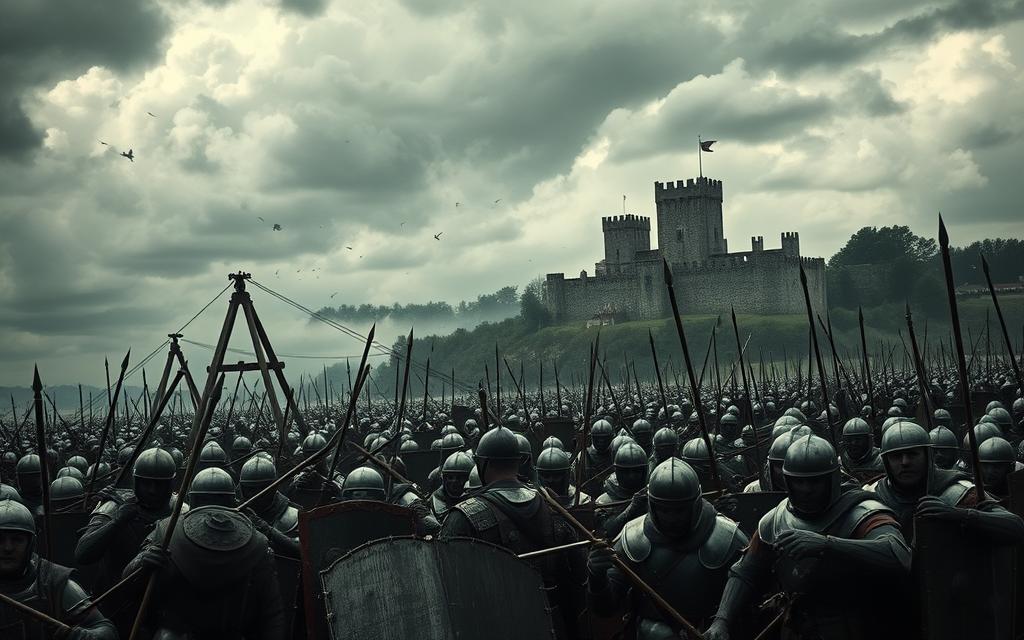
The Rise of Infantry as a Dominant Force
The Hundred Years War witnessed a crucial change in military tactics with the rise of infantry. Battles like Courtrai (1302) and Laupen (1339) showcased infantry forces defeating cavalry-centered armies, challenging centuries-old military doctrines. “For the first time almost since the days of the Romans,” as Oman rightly points out, “infantry, entirely unsupported by horsemen, ranged on a fair field in the plains, withstood an army complete in all arms and superior in numbers.”
The English were particularly innovative in their use of combined arms, integrating dismounted men-at-arms with longbowmen to create a formidable defensive system. This tactical innovation neutralized the traditional cavalry charge, making infantry the decisive factor in battle outcomes.
Dismounted Men-at-Arms and Their Role
Dismounted men-at-arms played a crucial role in the Infantry Revolution. By fighting on foot, these heavily armored warriors provided a stable anchor for the English formations, allowing longbowmen to operate effectively. This combination proved devastatingly effective against cavalry charges, as witnessed at Crécy (1346) and Poitiers (1356).
The French, after suffering significant defeats, were forced to adapt their tactics, increasingly fighting dismounted despite their cultural preference for cavalry warfare. This shift underscored the growing importance of infantry in medieval warfare.
Integration of Archers and Infantry Tactics
The integration of archers into infantry formations represented a significant tactical innovation. The “pike-and-shot” combination, featuring dismounted men-at-arms and longbowmen, created a defensive system that was highly effective against cavalry. The coordination between different types of infantry, such as pikemen, billmen, and archers, required greater discipline and training than previous medieval military systems.
This infantry revolution had profound social implications, as common soldiers now played a decisive role in battle outcomes, gradually increasing the political influence of non-noble classes. The effectiveness of infantry forces also encouraged broader recruitment from the general population, leading to larger armies and changing the economic and logistical aspects of warfare during this century.
The Introduction of Gunpowder Weapons
The Hundred Years War marked a pivotal moment in military history with the introduction of gunpowder weapons. This period saw the first significant military applications of gunpowder in Western Europe, beginning a technological revolution that would eventually transform warfare.
Early Cannons and Their Limitations
Early cannons appeared during the first phase of the war, with Edward III of England using primitive artillery pieces during the 1333 Siege of Berwick. These early cannons were made of iron and were used to supplement traditional siege engines like the trebuchet and catapult. However, they were limited by inconsistent powder quality, primitive metallurgy, and slow loading times, making them more psychologically effective than tactically decisive during the first century of their use.
The Ribauldequin (Organ Gun)
The ribauldequin, also known as an “organ gun,” was an early multi-barreled weapon that made its battlefield debut at Crécy in 1346. It consisted of several barrels arranged in a fan configuration or in parallel, sometimes mounted on a small cart, and fired small ball projectiles. Although the five ribauldequins at Crécy managed only three volleys in total, they represented an early attempt to increase firepower through multiple barrels.
Hand Cannons and Proto-Firearms
Hand cannons, the first portable firearms, began appearing in European armies during this period. These early hand cannons were wildly inaccurate, dangerous to use, and primarily employed for their shock effect on enemy horses and inexperienced troops. Despite their limitations, they marked the beginning of a new era in personal firearms.
Psychological Impact of Gunpowder Weapons
The psychological impact of these early gunpowder weapons often exceeded their physical effectiveness. The noise, smoke, and fire they produced terrified opponents unfamiliar with such technology, giving the users a significant psychological advantage on the battlefield.
| Weapon Type | Characteristics | Impact |
|---|---|---|
| Early Cannons | Primitive, made of iron, slow loading | Psychological, limited tactical |
| Ribauldequin | Multi-barreled, mounted on cart | Increased firepower, experimental |
| Hand Cannons | Inaccurate, dangerous to use | Shock effect, psychological |
By the later stages of the Hundred Years War, improvements in metallurgy and powder formulation had begun to transform these experimental weapons into more reliable and effective tools of war, setting the stage for the artillery revolution that would follow.
The Artillery Revolution: Transforming Siege Warfare
As the Hundred Years War drew to a close, a significant transformation occurred in siege warfare, known as the ‘Artillery Revolution.’ This period marked a crucial shift in the nature of warfare, as gunpowder weapons matured and became decisive in both battlefield and siege contexts.
Early Siege Artillery and Its Effectiveness
Early siege artillery of the 14th century was limited by primitive metallurgy. Early bombards were often constructed of iron bars bound together with hoops, making them dangerous to their operators and of limited effectiveness. Despite these limitations, the potential of gunpowder weapons was evident, and they continued to evolve throughout the century.
The early bombards were cumbersome and not very reliable, but they represented the beginning of a new era in siege warfare. Their ability to breach or damage fortifications, although limited, marked a significant departure from traditional siege engines.
The Development of More Powerful Bombards
By the mid-15th century, improved casting techniques allowed the creation of larger, more reliable bronze and iron cannons. These cannons were capable of firing stone or iron balls weighing up to several hundred pounds, significantly increasing their destructive potential.
The development of more powerful bombards had a profound impact on siege warfare. These weapons could systematically reduce castle walls that had previously been nearly impregnable, fundamentally altering the balance between offensive and defensive warfare for the first time in centuries.
How Artillery Changed Castle Design
Traditional castle designs with high, thin walls proved vulnerable to cannon fire, forcing a complete rethinking of fortifications across Europe in the decades following the war’s end. The French under Charles VII and his Master of Artillery, Jean Bureau, pioneered the systematic use of artillery trains, deploying hundreds of standardized pieces that could be transported between sieges and battlefields.
The artillery revolution transformed not just military technology but the entire political landscape of Europe. Centralized monarchies could now reduce the castles of rebellious nobles, consolidating state power in a way previously impossible.
| Century | Siege Artillery Development | Impact on Fortifications |
|---|---|---|
| 14th Century | Early bombards with limited effectiveness | Minimal impact, traditional designs still effective |
| 15th Century | More powerful bronze and iron cannons | Significant impact, traditional designs vulnerable |
| Post-War Period | Advancements in artillery continued | Complete rethinking of fortification designs across Europe |
The ‘Artillery Revolution’ during the Hundred Years War marked a pivotal shift in the nature of warfare, with gunpowder weapons becoming increasingly decisive. The development of more powerful bombards and the systematic use of artillery trains transformed siege warfare and had a lasting impact on the political landscape of Europe.
Naval Technology and Maritime Warfare
The Hundred Years War saw pivotal developments in maritime warfare, as control of the English Channel became strategically vital to both the English and French crowns. This period of conflict drove innovation in naval technology, transforming the way wars were fought at sea.
Advancements in Ship Design
Ship design evolved dramatically during the Hundred Years War. The development of purpose-built warships featuring higher forecastles and sterncastles provided platforms for archers and eventually naval artillery. The introduction of stern-mounted rudders, first depicted in the 1180s, replaced traditional steering oars, improving maneuverability and allowing for the construction of larger vessels capable of carrying more men and supplies.
The ship mill, a Byzantine invention from the 6th century, continued to be used during this period, showcasing the ongoing development of maritime technology. By the end of the war, ship design had incorporated purpose-built gun ports, presaging the development of dedicated warships that would dominate naval warfare for centuries to come.
Naval Artillery and Tactics
Naval artillery began to appear on ships by the mid-14th century. Early ship-mounted bombards were primarily used against enemy crews rather than to sink vessels. The use of iron in constructing these early naval guns marked a significant innovation in maritime warfare technology. The Battle of Sluys in 1340 demonstrated English tactical superiority, with archers on ships proving devastatingly effective against French crews.
“The English longbowmen, positioned on the ships, rained arrows upon the French, causing immense casualties.”
Impact on Control of the English Channel
Control of maritime supply lines became increasingly important throughout the century-long conflict, influencing campaign planning and strategic thinking. The naval innovations of this time laid the technological foundations for the Age of Exploration that would follow in the next century, enabling European powers to project force globally. By the end of the Hundred Years War, the stage was set for further advancements in naval technology.
| Innovation | Impact |
|---|---|
| Stern-mounted rudders | Improved maneuverability |
| Purpose-built warships | Enhanced naval warfare capabilities |
| Naval artillery | Increased firepower at sea |
The developments in naval technology during the Hundred Years War were crucial, not only for the outcome of the conflict but also for the future of maritime warfare. These innovations marked the beginning of a new era in naval power, setting the stage for European exploration and dominance of the seas in the centuries to come.
The Battle of Formigny (1450): Artillery’s Battlefield Debut
In 1450, the Battle of Formigny demonstrated the potential of field artillery in a European conflict for the first time. This battle marked a significant turning point in the Hundred Years War, as it showcased the emerging role of artillery on the battlefield.
The Strategic Situation
The Hundred Years War was nearing its end, with the French attempting to expel the English from Normandy. The English forces, led by Sir Thomas Kyriell, were positioned near Formigny, awaiting reinforcements. The French, under the Comte de Clermont, sought to intercept and defeat the English before they could regroup.
The strategic situation was tense, with both sides aware of the importance of the upcoming confrontation. The French had brought two small cannon, known as breech-loading culverins, which would play a crucial role in the battle.
Deployment of Field Artillery
The French deployment of field artillery at Formigny was a novel tactic for the time. The two culverins were used to target the English archers on the flanks, causing significant disruption to their formations. The English responded by charging the guns, but this ultimately led to their downfall.
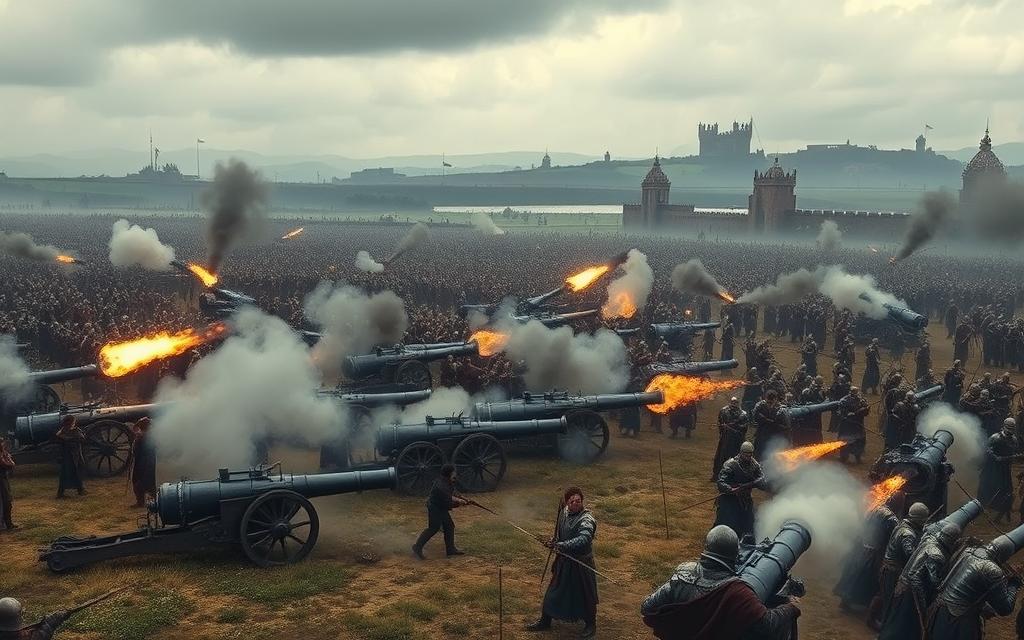
How Two Culverins Changed the Course of Battle
The presence of the culverins on the battlefield had a profound impact on the outcome of the battle. Not only did they disrupt the English lines, but the sound of the guns also drew reinforcements under Constable Richemont, who arrived with 1,200 mounted men. This timely arrival sealed the fate of the English forces.
“The guns had, in however small a role, arrived on the battlefield, marking a turning point in the history of warfare.”
The Battle of Formigny highlighted the growing importance of artillery in medieval warfare. The use of field artillery in this battle demonstrated its potential to influence the outcome of conflicts, signaling a shift away from traditional siege warfare.
| Aspect | Pre-Formigny | Post-Formigny |
|---|---|---|
| Artillery Use | Primarily siege warfare | Field artillery deployments |
| Tactical Impact | Limited to static engagements | Influenced battlefield dynamics |
| Technological Evolution | Early cannons and limited mobility | Development of more mobile and effective artillery |
The aftermath of the Battle of Formigny saw a significant shift in military tactics, with artillery becoming a central component of battlefield strategy. This marked the beginning of a new era in warfare, where the deployment of field artillery could decisively influence the course of a battle.
The Battle of Castillon (1453): The Triumph of Artillery
Jean Bureau’s mastery of artillery was instrumental in the French victory at Castillon in 1453, a battle that would change the face of warfare. The Hundred Years War, which had dragged on for over a century, was nearing its end, and the French were determined to drive the English out of their territory.
The French artillery corps, led by Jean Bureau, had been significantly enhanced since the Battle of Formigny. Bureau, described as ‘a perfectionist with a methodical, mathematical mind’ and ‘an imaginative technician who knew how to get the best out of his primitive weapons,’ had learned from his previous experiences, including the capture of his culverins by the English at Formigny.
Jean Bureau and the French Artillery Corps
Bureau’s appointment as Master Gunner of the French royal artillery by Charles VII was a strategic move. Having observed the effective use of cannons by the English, Charles VII directed that large numbers of guns be produced to counter the English advantage. Bureau’s expertise was crucial in this endeavor, as he not only understood the technical aspects of gunnery but also knew how to deploy artillery effectively on the battlefield.
“Jean Bureau was ‘a perfectionist with a methodical, mathematical mind’. The true father of French gunnery, he was further described as ‘an imaginative technician who knew how to get the best out of his primitive weapons’.”
The 300-Gun Battery
The French artillery corps, under Bureau’s command, brought an unprecedented 300-gun battery to the field at Castillon. This massive artillery force was supported by nearly 7,000 men, representing the first true artillery corps in European history. The scale and organization of this artillery force were revolutionary, signaling a new era in warfare where firepower would dominate the battlefield.
The deployment of such a large number of guns required significant logistical support, including the transportation of the guns, ammunition, and the men to operate them. Bureau’s planning and execution were meticulous, ensuring that the artillery was positioned effectively behind field fortifications, creating a deadly trap for the attacking English forces.
| Artillery Type | Number Deployed | Role |
|---|---|---|
| Culverins | 100 | Long-range bombardment |
| Bombards | 150 | Siege and battlefield destruction |
| Other Guns | 50 | Supporting firepower |
The End of English Dominance
The English force, led by John Talbot, Earl of Shrewsbury, was experienced but fatally underestimated the power of the French artillery. As the English advanced, they were subjected to a devastating barrage that inflicted massive casualties before they could even close to combat range. The English defeat was total, with Talbot himself killed along with thousands of his men.
The Battle of Castillon marked not only the end of the Hundred Years War but also symbolically the end of medieval warfare, as the dominance of the mounted knight gave way to the era of gunpowder and professional armies. The victory at Castillon was a testament to the revolutionary impact of artillery on the battlefield, a lesson that would be studied by military leaders for centuries to come.
Military Organization and Logistics
Military organization underwent a radical transformation during the Hundred Years War, driven by the need for more effective and sustainable forces. The prolonged conflict necessitated innovations in how armies were structured, supplied, and financed.
The Compagnies d’Ordonnance: Europe’s First Standing Army
In the 15th century, Charles VII of France introduced the Compagnies d’Ordonnance, marking a significant shift towards a professional, standing army. This move was revolutionary, as it replaced the traditional feudal levies and mercenary companies with a permanent force under direct royal control. The Compagnies d’Ordonnance were formed by incorporating ‘Free Companies’—foreign mercenaries—into royal service, thereby reducing the threat they posed to civilian populations and enhancing the king’s military capabilities.
The creation of a standing army had far-reaching implications. It not only improved military effectiveness but also contributed to the centralization of royal authority. As historian Philippe Contamine noted, “The establishment of the Compagnies d’Ordonnance was a crucial step in the development of the modern state, as it tied military power directly to the crown.”
Supply Chains and Campaign Planning
The logistics of sustaining large armies in the field for extended periods drove significant innovations in supply chains and campaign planning. Commanders had to coordinate the movement of artillery trains, supply convoys, and various force elements across vast geographic areas. This complexity required sophisticated administrative structures and financial systems, laying the groundwork for modern military logistics.
Effective campaign planning became crucial, as armies needed to be supplied with food, ammunition, and other necessities over long campaigns. The ability to manage these logistical challenges often determined the success or failure of military operations.
Financing Warfare and Economic Impact
The financial burden of the Hundred Years War was immense, forcing innovations in taxation and state finance. Both England and France saw a centralization of royal authority as monarchs sought to finance their war efforts. The war’s enormous costs drove the development of more sophisticated financial systems, including the use of credit and the establishment of more efficient tax collection mechanisms.
The economic impact of the war was profound, affecting not only the belligerents but also the broader European economy. The prolonged conflict led to the rise of a distinct military profession, separate from the nobility, as professional soldiers became the backbone of armies on both sides.
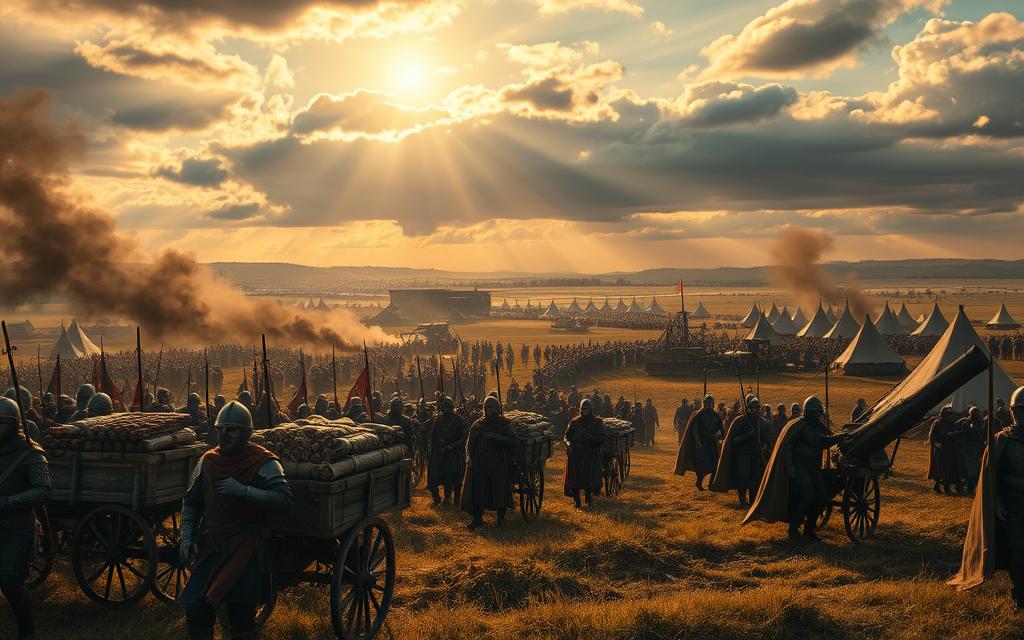
The integration of different arms, such as cavalry, infantry, and artillery, required more complex command structures and battlefield communications. This led to the development of more sophisticated military hierarchies, further professionalizing the armed forces.
In conclusion, the Hundred Years War was a catalyst for significant changes in military organization and logistics. The innovations that emerged during this period, from the creation of standing armies to advancements in supply chain management and financial systems, laid the foundations for modern military practices.
Fortifications and Defensive Technology
The Hundred Years War saw substantial advancements in fortification design, driven by the introduction of gunpowder artillery. As siege warfare evolved, the need for more robust defensive structures became increasingly evident.
Castle Design Before Gunpowder
At the beginning of the Hundred Years War, castle design represented the pinnacle of medieval defensive technology. High stone walls, towers, and keeps had proven effective against traditional siege methods for centuries. However, the introduction of gunpowder artillery gradually rendered these traditional fortifications obsolete.
- High stone walls were vulnerable to cannon fire.
- Towers and keeps were often too exposed.
- Traditional siege methods were no longer effective.
As gunpowder artillery improved, defensive adaptations began to appear. By the mid-15th century, innovations such as reinforced walls, angled bastions to deflect shots, and lower, thicker curtain walls that could better absorb the impact of cannonballs became more common.
Adaptations to Counter Artillery
The war accelerated the development of artillery fortifications. Early examples appeared in the final decades of the conflict as castle owners and town defenders sought to counter the new threat. Key adaptations included:
- Reinforced walls to withstand cannon fire.
- Angled bastions designed to deflect shots.
- Lower, thicker curtain walls for better protection.
For more information on the evolution of siege warfare, visit Sieges: An Introduction.
The Transition to Trace Italienne Fortifications
The full transition to the trace italienne style, characterized by star-shaped fortifications with angled bastions and wide ditches, occurred in the decades following the war. This represented the defensive response to the artillery revolution. The new fortification designs fundamentally changed the nature of siege warfare, requiring attackers to deploy even more artillery pieces and develop more sophisticated approaches to reduce defensive positions.
The enormous cost of building and maintaining these new fortifications accelerated the centralization of political power, as only wealthy monarchs and states could afford to properly defend strategic towns and borders. The technological arms race between offensive artillery and defensive fortifications would continue for centuries, driving further military innovations and shaping the political landscape of Europe.
Non-Military Technologies of the Period
While the Hundred Years War drove military innovation, it also coincided with remarkable technological advancements in other areas of European society. The period saw significant developments that transformed various aspects of life, from agriculture to information dissemination.
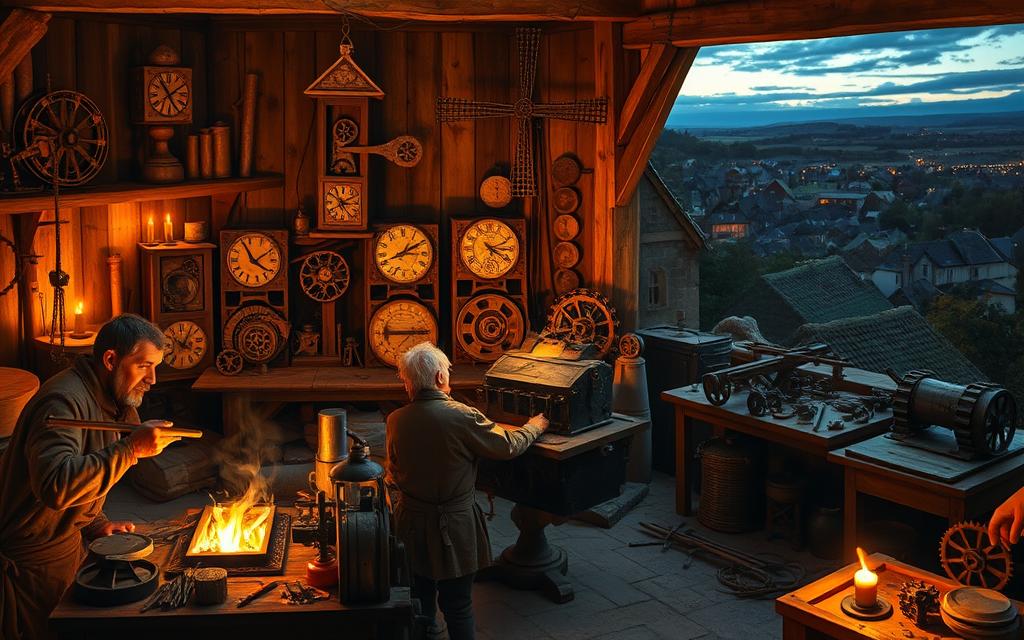
Agricultural Innovations
The Hundred Years War era witnessed crucial advancements in agricultural technology. Innovations such as improved plows, horse collars, and three-field crop rotation systems significantly increased food production. These developments were vital in sustaining populations despite the disruptions caused by the war.
- Improved plows allowed for more efficient tilling of the soil.
- The introduction of horse collars enabled the use of horses for plowing, increasing productivity.
- Three-field crop rotation systems enhanced soil fertility and crop yields.
These agricultural innovations not only supported the growing population but also played a crucial role in maintaining larger armies, thereby indirectly influencing the course of the war.
Mechanical Clocks and Timekeeping
The 13th to 14th centuries saw the introduction of mechanical clocks in European town towers. These weight-driven clocks revolutionized timekeeping, beginning to regulate urban life and changing how people conceptualized time itself.
The hourglass, first documented in 1338 in Siena, Italy, provided a portable and reliable measure of time. Unlike water clocks, the rate of flow of sand in an hourglass is independent of the depth in the upper reservoir, making it a more accurate and dependable timekeeper.
Key benefits of mechanical clocks and hourglasses included:
- Improved coordination of daily activities.
- Enhanced navigation capabilities.
- Better timekeeping for scientific experiments and military operations.
Printing and Information Dissemination
The period of the Hundred Years War also saw early developments in printing technology, culminating in Gutenberg’s printing press in the 1450s. This innovation transformed information dissemination, making written materials more widely available and contributing to a significant increase in literacy rates.
The impact of printing was not limited to the dissemination of religious texts; it also facilitated the spread of tactical knowledge, literary works, and scientific discoveries. This technological advancement played a crucial role in laying the groundwork for the Renaissance and the later Scientific Revolution.
As the war drew to a close, the stage was set for a new era of cultural, scientific, and intellectual growth, driven in part by the technological innovations of the preceding centuries.
Social Impact of Technological Change
As the Hundred Years War progressed, technological innovations began to alter the traditional power dynamics within society. The significance of the Infantry Revolution, which reached its peak in the 1340s and 1350s, extends far beyond its immediate impact on the conduct of war. The growing importance of common infantry on the battlefield was reflected in the political influence of the commons, especially in nations like England and Switzerland where this revolution was most pronounced.
The Declining Role of the Nobility
The technological changes during the Hundred Years War had profound social consequences, reshaping the relationship between different classes and altering traditional power structures. The declining military effectiveness of knights and heavy cavalry challenged the nobility’s traditional role as the primary military class, undermining one of the key justifications for their privileged social position.
The nobility’s role in warfare was significantly impacted by the introduction of new technologies and tactics. As infantry and archers became more prominent, the traditional dominance of the nobility on the battlefield began to wane.
| Technological Change | Impact on Nobility | Social Consequence |
|---|---|---|
| Introduction of Infantry | Decline of Knights | Reduced Nobility Influence |
| Rise of Archers | Shift from Cavalry | Increased Commons Power |
| Advancements in Artillery | Decreased Importance of Heavy Armor | Changes in Military Recruitment |
Rise of the Commons and Political Power
The rising importance of common soldiers, particularly archers, pikemen, and eventually gunners, gave the non-noble classes greater political leverage. Rulers now depended on their military service, leading to increased political power for the commons. In England, the military contribution of yeoman archers coincided with the increasing power of the Commons in Parliament.
The professionalization of warfare led to changes in military recruitment, with service increasingly based on pay rather than feudal obligation. This created new career paths outside traditional social structures, allowing some commoners to rise through the ranks, particularly in artillery and engineering corps where technical knowledge was more important than noble birth.
Changes in Military Recruitment and Service
The enormous costs of new military technologies, especially artillery, and larger armies forced rulers to seek broader tax bases. This required greater consultation with representative bodies, expanding political participation and further empowering the commons.
By the end of the Hundred Years War, the concept of warfare as the exclusive domain of the chivalric class had been thoroughly undermined, reflecting broader changes in how medieval society organized itself. The social mobility created by military service played a significant role in this transformation.
Legacy of Hundred Years War Technology
The Hundred Years War marked a crucial period in the development of military technology that would shape European warfare. The innovations that emerged during this conflict had far-reaching consequences, influencing military engineering, tactics, and the broader political landscape.
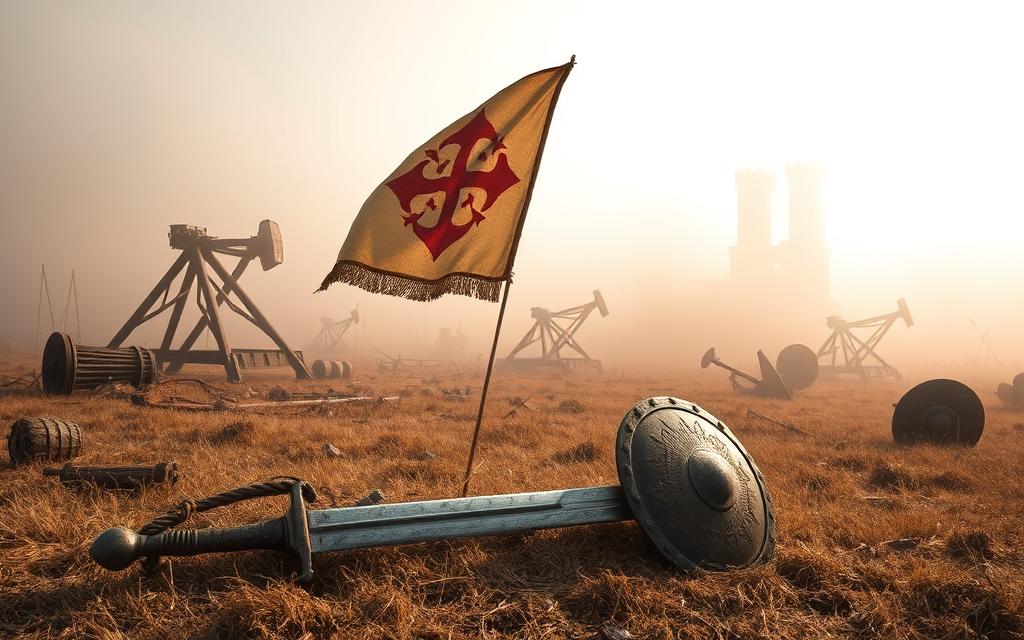
Influence on Renaissance Military Engineering
The technological advancements made during the Hundred Years War directly influenced Renaissance military engineering. Military engineers of the Renaissance, including Leonardo da Vinci, built upon the artillery and fortification technologies developed during the war. They refined and systematized these innovations, leading to further breakthroughs in siege warfare and defensive structures. The experience gained from the Hundred Years War allowed for the development of more sophisticated artillery systems and fortifications that could withstand such weaponry.
The use of gunpowder weapons, which became more prevalent during the Hundred Years War, continued to evolve in the following centuries. The introduction of more advanced artillery pieces and the development of new fortification designs, such as the Trace Italienne, were direct responses to the changing nature of warfare. These advancements laid the groundwork for the military engineering feats of the Renaissance.
Foundations for European Military Dominance
The shift from cavalry-dominated armies to those centered around infantry and artillery, which occurred during the Hundred Years War, established the basic military paradigm that would enable European global expansion. The Infantry Revolution was a necessary precondition for the European conquests of the sixteenth through eighteenth centuries. The ability to field large, disciplined infantry forces supported by artillery gave European armies a significant advantage over their adversaries.
The organizational innovations that took place during this period, particularly the development of standing armies and professional artillery corps, provided the institutional framework for the military systems that would dominate the early modern period. This shift in military organization and technology helped to centralize power and alter the balance of military strength in Europe.
Technological Continuity into the Early Modern Period
The technological innovations of the Hundred Years War laid crucial foundations for European military developments over the next several centuries. The continuous arms race between offensive and defensive technologies drove ongoing innovation in military engineering. The development of gunpowder weapons continued, with improvements in artillery design and the introduction of new types of firearms.
Naval technologies developed during the war, including improved ship designs and naval artillery, formed the basis for the vessels that would later explore and conquer much of the globe. The legacy of the Hundred Years War included a lasting impact on the nature of warfare, extending its influence into the early modern period and beyond.
The Military Revolution: A Broader Perspective
Understanding the evolution of warfare during the Hundred Years War provides valuable insights into the development of modern military strategies. The conflict, which lasted from 1337 to 1453, was a crucible for military innovation, driven by the need to adapt to new technologies and tactics.
The Hundred Years War as the First Military Revolution
The Hundred Years War represents an earlier and equally profound transformation in warfare that deserves recognition as the first in a series of military revolutions. During this century-long conflict, two distinct revolutionary changes occurred: the Infantry Revolution, which elevated foot soldiers over cavalry, and the Artillery Revolution, which transformed siege warfare and battlefield tactics.
These changes fundamentally altered the conceptual framework of warfare, shifting from a medieval paradigm dominated by aristocratic heavy cavalry to an early modern system centered on combined-arms forces and firepower. The Infantry Revolution marked a significant shift in the balance of power on the battlefield, as foot soldiers became the dominant force.
Sequential Revolutions in Military Technology
Rather than viewing military history as experiencing a single revolutionary period, we can better understand it as a series of punctuated equilibrium events, each responding to and building upon previous innovations. The Hundred Years War innovations created disequilibrium in the military system, leading to counter-innovations in fortifications and tactics during the 16th-17th centuries, which in turn prompted further developments.
This perspective places the war in a broader historical context, connecting medieval military developments directly to the changes that would enable European global dominance in subsequent centuries. The technological and organizational changes of the period 1337-1453 were as revolutionary in their time as the more famous innovations of the early modern period, fundamentally altering how states projected power and conducted warfare.
From Medieval to Modern Warfare
By understanding the Hundred Years War as part of this longer developmental arc, we gain insight into how military technology evolves not in isolation but as part of an ongoing process of innovation, adaptation, and counter-innovation. The war marked a significant turning point in the history of warfare, as it transitioned from medieval to modern forms.
The legacy of the Hundred Years War can be seen in the subsequent development of military technology and tactics, as European powers continued to innovate and adapt in response to new challenges. The conflict laid the groundwork for the military revolutions of the early modern period, shaping the course of world history.
Conclusion: How the Hundred Years War Changed Warfare Forever
Throughout the Hundred Years War, technological developments played a crucial role in shaping the course of battle and the future of warfare. This conflict, which lasted from 1337 to 1453, saw the introduction and development of various technologies that had a lasting impact on military tactics, the role of different branches of the military, and the broader social and political landscape.
The longbow, a revolutionary weapon that dominated the early phases of the war, represented a significant shift in military technology. Its ability to be produced at scale and wielded effectively by common soldiers challenged the primacy of heavily armored knights for the first time in centuries. The longbow’s impact on the battlefield was profound, allowing English forces to achieve decisive victories at Crécy, Poitiers, and Agincourt.
The evolution from chain mail to plate armor during the Hundred Years War demonstrates the ongoing technological arms race that characterized this period. Defensive innovations constantly responded to improvements in offensive weapons, leading to the development of more sophisticated and protective armor. This arms race not only influenced battlefield tactics but also had significant implications for the cost and logistics of warfare, favoring those who could afford the latest technological advancements.
The rise of infantry as the dominant battlefield force fundamentally altered the social dynamics of warfare. By elevating the military role of common soldiers, the Hundred Years War contributed to broader political changes, challenging the traditional dominance of the nobility and paving the way for the rise of the commons. This shift had far-reaching consequences, both on and off the battlefield.
Artillery development during the latter part of the war represented perhaps the most revolutionary change. Gunpowder weapons evolved from curiosities to decisive battlefield forces capable of reducing previously impregnable fortifications. The battles of Formigny and Castillon demonstrated how even small numbers of guns could change the course of battle, while larger artillery trains transformed siege warfare from operations of months or years to matters of weeks.
Naval innovations during this period laid the groundwork for European maritime dominance. Improvements in ship design, navigation, and naval artillery enabled global exploration and conquest, setting the stage for European powers to establish themselves as major world powers in the centuries that followed.
Organizational changes, particularly the development of Europe’s first standing armies and professional artillery corps, created institutional frameworks that would define military structures for centuries to come. The technological weight of these innovations fell increasingly on centralized states rather than individual nobles, accelerating the development of modern state structures capable of projecting power more effectively.
The legacy of these innovations extended far beyond the battlefield, reshaping European society, politics, and eventually enabling the global dominance that European powers would achieve in subsequent centuries. By understanding the technological developments during the Hundred Years War, we gain insight not just into military history but into the technological foundations of the modern world order.
